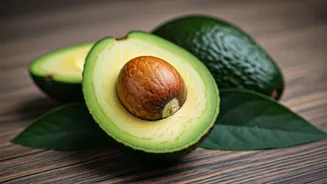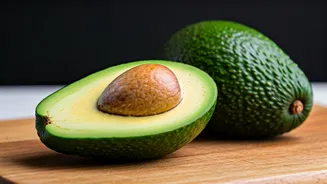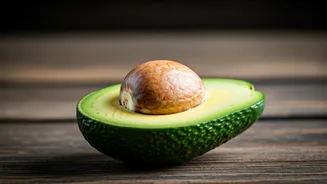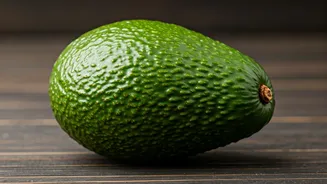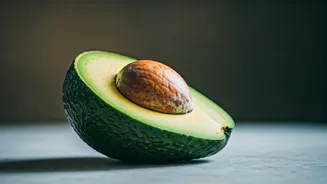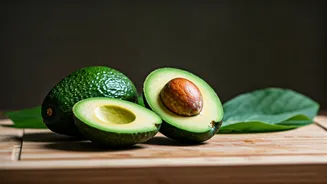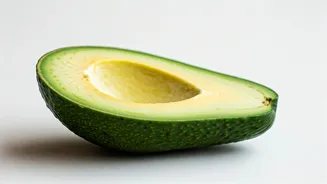Skin Deep Clues
The avocado's skin offers the first clues about its readiness. Color is a primary indicator, although it varies by variety. For Hass avocados, the most
common type, a shift from green to a dark purplish-black usually signals ripeness. However, other types may turn from green to yellowish-green. But, do not rely solely on color. The presence of tiny, dark freckles or speckles can indicate the fruit has been stored at the incorrect temperature. These imperfections do not affect the taste but are signs that the fruit may be past its prime. Examine the skin closely. If it appears bruised, damaged, or deeply indented, it is likely the avocado is bruised and may have been mishandled.
The Gentle Squeeze Test
Feeling the avocado is the crucial step. Gently apply pressure to the fruit. A ripe avocado should yield slightly to gentle pressure. If it feels firm, it needs more time to ripen. If it feels extremely soft or mushy, it is likely overripe. Aim for a firmness that allows a small indentation when gently squeezed. This suggests that the fruit is ripe and ready to be enjoyed. The feel test is especially important because it helps gauge the texture of the flesh. A slightly soft feel indicates that the flesh has the right amount of softness for consumption. However, this is not always the best way to determine ripeness; the stem is a much better choice.
Check the Stem
The stem area provides the most reliable ripeness clue. Gently remove the small stem cap at the top of the avocado. Beneath the stem, the color reveals the state of the fruit. If the area under the stem is green, the avocado is ripe and ready to eat. If it's brown, the avocado is likely overripe. If the stem does not come off easily, the avocado may not be ripe yet. Be sure to check this area carefully as the color change is a great indicator of ripeness. Checking the stem is more reliable than merely squeezing the fruit because it provides a direct glimpse into the flesh's maturity. This also helps assess the fruit's internal condition.
Weight and Feel
Consider the weight of the avocado. A ripe avocado should feel heavy for its size. This is because the flesh inside is soft and has a higher moisture content. An avocado that feels light might be less ripe or have less flesh. In addition to the gentle squeeze test and the stem inspection, compare the weight of different avocados to make a more informed decision. The heavier the avocado is, the riper it most likely is. If you're comparing several avocados, select the one that feels the heaviest. This suggests a higher water content, and thus a more ripe avocado.
Avoiding Bruises
Examine the avocado's surface for any bruises or soft spots. Bruises usually appear as dark, indented areas on the skin. Although a few small blemishes might be acceptable, significant bruising can affect the texture and taste of the avocado. Avoid any avocados that show signs of damage. If an avocado has been dropped or roughly handled, it will develop bruises. Bruises can result in a change in texture and flavor, resulting in a less pleasant eating experience. Choose avocados carefully to avoid this issue.
Ripening at Home
If you purchase an avocado that is not yet ripe, you can speed up the ripening process at home. Place the avocado in a paper bag with a banana or an apple. These fruits release ethylene gas, which helps accelerate ripening. Check the avocado daily and use the above methods (skin color, feel, stem) to determine its readiness. It usually takes a few days. You can also ripen avocados at room temperature. But keep in mind that the speed of ripening can vary depending on the avocado and the ambient temperature. If you need it to ripen faster, putting it in a bag with a banana is a great way to do so.
Storage Solutions
Once the avocado is ripe, it can be stored in the refrigerator to slow down the ripening process. This can extend its shelf life by a few days. Wrap the whole avocado in plastic wrap and place it in the crisper drawer of your refrigerator. To store a cut avocado, leave the pit in one half. Drizzle lemon or lime juice on the cut surface to prevent browning, and then wrap the avocado tightly in plastic wrap. Consume within a day or two for the best taste and texture. Properly storing avocados is important for enjoying them at their best, and the advice will ensure freshness.



